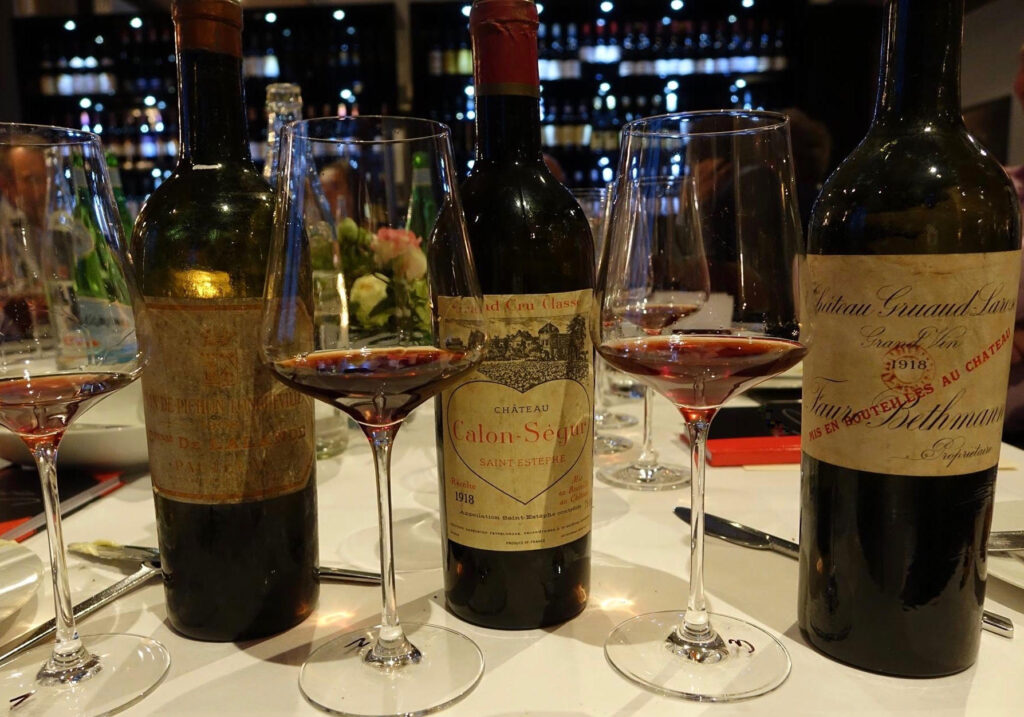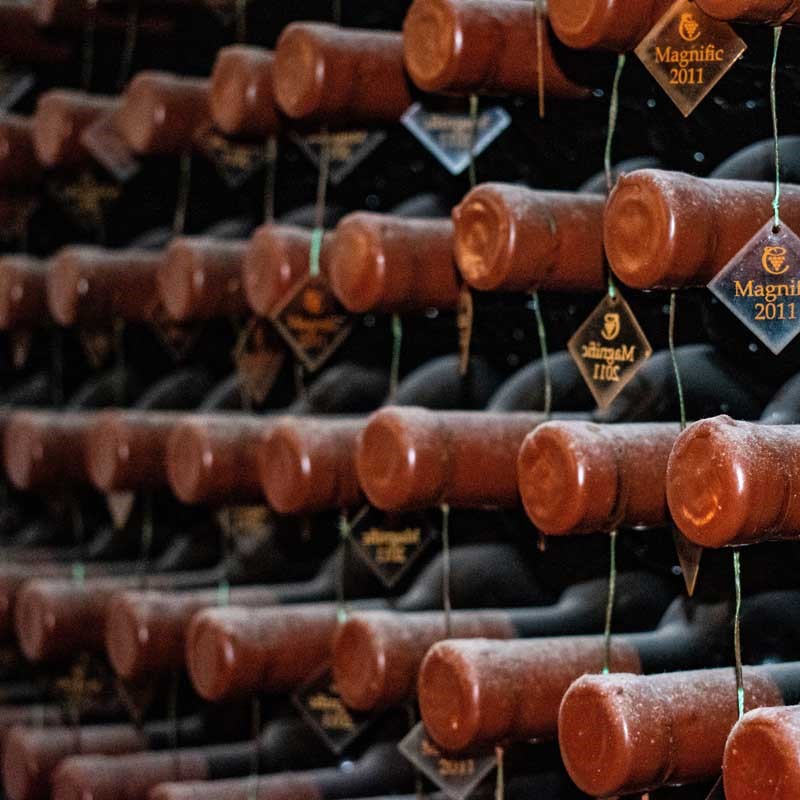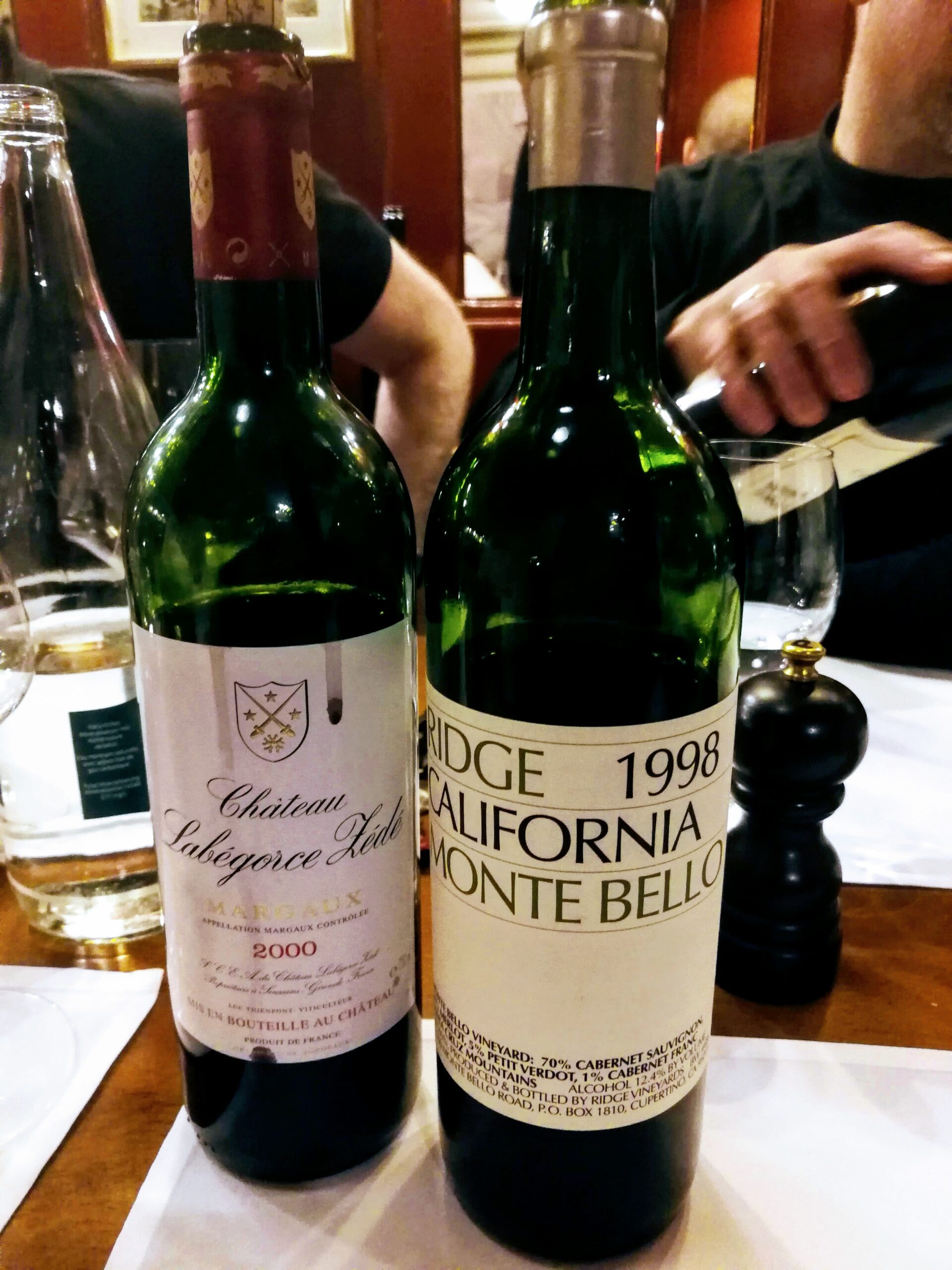Wine storage is a complex subject: Why do many wines improve when the bottles lie in a cool, dark cellar for years? Why is temperature important in wine storage? What happens to a bottle of wine while it is aging in the cellar? And what happens instead when it is mistreated on the mantel? These are the questions I want to explore in this post.
Most wines are ready to drink when they hit the market, and they don’t get better with prolonged cellaring. They will also only last a few years before they are over. Meant are almost all wines under 5 EUR per bottle, to name a house number. Wines in this price segment make up the overwhelming majority of all wines. It will not be about these here. Nor about those in the price range up to 10 EUR, which sometimes benefit from two or four years of cellar maturity. I know, I’m generalizing now – but this simple classification according to price groups works very well in this case, even if there may be exceptions. Here it should be about high-quality wines, especially red wines in the league of Bordeaux Grand Cru Classé, Barolo, Côte Rôtie, or Grand Crus from Burgundy, which benefit from cellar maturity.

Provided perfect storage and good corks, some wines can live 100 years or more without developing off-flavors
These wines go through different stages of life. Almost all of them can be drunk very young, in the first years after they came to the bottle, with great pleasure. I will explain why this is so. Many then close up, become hard, unbalanced, and do not give pleasure. After a few more years they come into their splendid drinking maturity. How long this takes depends on the individual wine. For some, three or four years are enough; another extreme, for example, was the 1928 Latour, which took almost 50 years to get into a good drinking window. According to old reports, it was barely drinkable with tannin through the 50s and 60s, then blossomed in the 70s and 80s and became one of the greatest wines ever. But fortunately for most storable wines, it is usually only 10 to 20 years (counting from the vintage) before drinking maturity is reached.
Wine is an extraordinarily complex mixture of substances. Of course, it is composed very predominantly of water, followed by ethanol – in a dry red wine, these two components account for about 97 – 98%. The music plays in the remaining 2 – 3%. Even if that, the lion’s share is glycerol, the acids (malic acid, tartaric acid, lactic acid, succinic acid), and the residual sugar found in even the driest red wine. Then come about 0.2 – 0.3% minerals and about the same amount of phenols, which play a central role in the aging of the wine. Only about 0.1% of the wine consists of aroma substances, an exploded pharmacy of about 1000 different components, which can be assigned to different substance classes such as esters, aldehydes, or terpenes. They make up the soul of a wine, and they distinguish a Pinot Noir from Burgundy from a Cabernet Sauvignon from Napa. The interested reader will have realized by now at the latest that it is not possible to understand the aging of wine without chemistry.
Chemical processes during wine storage
In the last 20 years, thanks to enormous advances in instrumental analysis, a great many wine constituents have been identified and mechanisms of wine aging have been elucidated. I divide the ripening processes into four groups:
- Purely physical processes, essentially the precipitation or crystallization of dissolved ingredients.
- Chemical reactions take place between the ingredients. Most important here are hydrolysis of esters and glycosides, transesterification, and addition and rearrangement reactions.
- Chemical reactions involve oxygen, which slowly diffuses into the bottle. No wine closure is absolutely gas-tight; around 10 to 100 mg of oxygen per year pass through an intact cork, and a few milligrams of oxygen also pass through screw caps every year.
- Chemical reaction cascades are induced by oxygen. The reaction with oxygen often produces reactive intermediates, which in turn react with other ingredients of the wine to form reactive components, etc.
There is another group of reactions that will only be briefly considered here: Photochemical reactions, which are triggered by light. These are among the fastest chemical reactions, also in wine storage. They are triggered by photons, i.e. light, and usually cannot take place without light, because they are then quantum chemicals forbidden. Photochemistry is the reason why wine must be stored in the dark. Riboflavin plays an important role in this process. It is converted into an aggressive triplet state by light and then, for example, oxidizes the amino acid methionine in the wine to methional, which smells like cooked potatoes. This then produces, among other things, methanethiol – one of the crucial components of bad breath – and dimethyl disulfide, a foul-smelling substance that helps give stinkhorn its nasty odor, for example. Bright light is wine’s greatest enemy, and I would never buy a bottle that I knew had been standing – even for just a few days – in an unprotected shop window or had once been tortured as a trophy wine on the mantelpiece. Short-wave light, i.e. UV, blue and green light, is particularly harmful, while yellow and red light causes less damage. It is best for the wine to be allowed to mature in complete darkness.
Chemistry is crucial
Now to the physical processes during wine storage. The best known is probably the crystallization of tartar. This is a salt of tartaric acid, namely potassium hydrogen tartrate and calcium tartrate. Tartar does not bother because the wine can be easily decanted from it, and because the formation of tartar has practically no sensory effect on the wine. Another important component of the deposit that forms in red wines over time is tannin. This usually does not precipitate out of the wine until it is polymerized by chemical reactions. More on this later.

with original Depot of a 2008 Léoville Poyferré
The first group of chemical reactions does not require oxygen. These play an important role in the aging of wine. Many fruit aromas chemically belong to the group of esters. For example, they can smell like pineapple (butyric acid ethyl ester), orange ((S)-2-methyl butyric acid ethyl ester), passion fruit (hexyl hexanoate), pear (isoamyl butyrate), banana (isobutyl acetate), apple (acetic acid hexyl ester) or plum (cinnamic acid methyl ester). They are part of the reason that almost all wines go through a delicious fruit phase shortly after bottling. However, esters are quite unstable in acidic aqueous solution – and that is exactly what wine is – they are hydrolyzed into their acid and alcohol; the intense fruit aromas disappear after a few years. Incidentally, many pure-breeding yeasts are trimmed to produce special fruit esters. Many cheap white wines get their intense fruit aromas from pure culture yeasts. And that is exactly why they have to be drunk soon because after only a few years all these fragrant esters are destroyed by hydrolysis. Another group of fruit aromas, which belong to the terpenes, are chemically very inert and last for decades. Limonene and myrcene, which smell like citrus fruits, are among them.
Glycosides are also important components of wine, for example, anthocyanins. Glycosides consist of a sugar part and an often more hydrophobic aromatic residue. In the course of time, the bond between these two molecule parts is hydrolyzed. Thus, on the one hand, sugars are released, which is why the sugar content in the wine increases very slightly with storage, and on the other hand, anthocyanins are formed from the anthocyanins, for example, which can participate in further reactions as polyphenols.
The volatile aromas in wine
An important group of aromas is the aldehydes. For example, decanal smells like orange peel or (E)-2-hexenal smells like apple. Many of the lower (small) aldehydes are volatile and thus contribute to the bouquet of the wine. Benzaldehyde smells of bitter almond and marzipan, vanillin, whose molecular structure is similar to benzaldehyde, smells naturally of vanilla, hexanal smells vegetal green, of freshly cut grass and tomato leaves, and furfural smells of bitter almond, caramel, and malt. The aldehyde group is quite reactive and readily reacts with nucleophiles such as amines or thiols, which are also present in wine – sulfur dioxide also reacts with some aldehydes. Flavonoids, an important group of substances in wines, can be coupled together by acetaldehyde – an important mechanism in the aging of wines. Acetaldehyde, which is formed with oxygen from ethanol, for example, can link tannin molecules together, making the wine softer and less astringent. Redoxchemically, aldehydes stand between the alcohol and the carboxylic acid, and therefore they will reappear in the section on oxygen-induced reactions.
The warmer the wine storage, the faster the wine matures?
Most chemical reactions take place faster the higher the temperature. In the 19th century, the chemist Jacobus van’t Hoff formulated the RGT rule (reaction rate-temperature rule), according to which chemical reactions take place two to four times faster when the temperature is increased by 10°C. This rule is a very rough simplification that applies only in the vicinity of room temperature. While this rule is a very gross simplification that only applies near room temperature, it is quite helpful over the broad thumb.
Wouldn’t a wine than simply have to ripen faster at 22°C than at 12°C? Yes and no! In fact, a wine will ripen faster at a slightly higher temperature. But the result is not the same! This is because wine is an enormously complex mixture of thousands of different substances, in which an incredible number of different reactions take place. And not all reactions are accelerated to the same extent when the temperature increases. That’s why the RGT rule is only a vague rule of thumb. So at 22°C, some reactions run 8 times faster, others only twice as fast as at 12°C. And because we are dealing with reaction cascades, the products of the individual reactions, in turn, react further with other reaction partners, and their reaction rates depend on the concentrations of the reactants, a temperature difference of 10°C leads to a completely different result.
A wine that has been stored for 5 years at 22°C smells differently, tastes differently, is a different mixture of substances than a wine that has been allowed to mature for 10 years at 12°C. The result is not the same if you boil a freshly laid egg in water at 100°C for 5 minutes or keep it at 37°C for 3 weeks. The perfect cellar temperature is around 12°C, with 10 to 15°C considered the optimal range. Admittedly, it is no problem to store a young wine at 20°C for a year – it is only for long-term storage and maturation of wines that such high temperatures are unsuitable.
The exchange of oxygen in the bottle
During wine storage, minute amounts of oxygen continuously enter the wine through the closure. No organic material is diffusion-proof against oxygen. This gas also diffuses through a cork, the diffusion coefficient was determined to be around 10-9 m-2s-1, showing a very wide range of variation (J. Agric. Food Chem. 2012, 60, 13, 3348-3356); diffusion through cork follows Fick’s law – a finding that proves the diffusion process (J. Agric. Food Chem. 2014, 62, 37, 9180-9185). That is, a very rough 10 mg of oxygen diffuses through a cork per year – which is significantly more than is contained in the air space of the sealed bottle. This oxygen plays a role in the aging of wines, and it is obvious that too much of it is undesirable during wine storage.
Tartrate and sediment
In addition to the tannin, red wine also contains procyanidins and monomeric as well as oligomeric catechins, mainly as gallocatechin (these are flavanols with a gallate residue, which is also a structural element of tannin). These are responsible for the harsh, astringent, and sometimes bitter impression of closed, too young red wines. All these substances are polyphenols that can oxidatively couple and polymerize when exposed to oxygen. This polymerization can lead to the formation of deposits because the solubility of polymers decreases with their molar mass. However, it also causes the tannins in the wine to “ripen,” becoming less harsh and astringent. An essential process in the desired ripening of wine is therefore the oxidative coupling of polyphenols, which requires oxygen. The decisive factor is not only the absolute amount of oxygen available but also the respective concentration of oxygen at a given time. If this is too high, too many other undesirable oxidations take place – for example, that of alcohols to aldehydes or ketones. The supply of oxygen must therefore be very slow so that a so-called dynamic equilibrium (steady state) is maintained at a very low concentration of free oxygen.
How much oxygen the tannins of wine can consume in total depends on the amount and composition of these tannins, this potential is also called TRC (total reducing capacity) or also TEAC (Trolox Equivalent Antioxidant Capacity). The air space in a freshly filled wine bottle is about 5 ml, which corresponds to about 1.4 mg or 0.045 mmol of oxygen. A typical red wine contains about 4000 mg/l GEA (gallic acid equivalents), which corresponds to a TRC of roughly 20 mmol/l (see, e.g., Food and Nutrition Sciences 05(17), 1660-1667). The oxygen in the air space of a sealed bottle can therefore oxidize only 0.3% of the tannins contained in the wine.
In very young wines, the tannins are often less astringent and harsh. This is because their attachment to the proteins of the oral mucosa becomes more aggressive when the polyphenols have reached a certain size. After a few years, they have become so long-chained through oxidative coupling that they make the wine seem particularly harsh. Only with further growth do the tannins interact more strongly with themselves and have a softer effect, until they finally precipitate as a deposit.

Thanks to perfect cellar conditions, these two Pauillac from 1917 were still in a very good condition
Stable conditions during wine storage
At least as important as the right temperature is the absence of temperature fluctuations when storing wine. Frequent temperature fluctuations of several degrees Celsius are poison for a wine. An absolutely constant temperature is ideal. If the temperature fluctuates in annual rhythm with the seasons, this is not a bad thing. A natural cellar (i.e. a cellar that is not technically air-conditioned) fluctuates around the average annual temperature of the region. The deeper the cellar is in the ground, the smaller this annual temperature amplitude is. Only at a depth of around 12 – 15 m is the ground temperature constant throughout the year and corresponds exactly to the average annual temperature at ground level. In Central Europe, the annual temperature variation at a depth of 2 m is already 13°C. It becomes harmful for the wine when the temperature fluctuates with the weekly weather or, in the worst case, daily with day and night. But why is this so? This is where physics comes into play. While solids like glass expand very little with temperature, the thermal expansion of liquids is much greater. Gases want to expand even more with temperature, but unlike liquids, they are compressible – if you confine them, pressure rises with temperature because they can’t expand. In a wine bottle, 750 ml of wine and about 3 to 6 ml of gas share the space. When the temperature rises by 10°C, the pressure in a wine bottle increases by several bars due to the thermal expansion of the liquid. Since corks are not diffusion-tight and pressure differences accelerate diffusion, each significant increase in temperature forces more water and ethanol vapor out of the bottle, and as temperatures drop, the air is drawn into the bottle. If this happens 20 times in 20 years, the effect is negligible, but if it happens 1000 or 5000 times, the effect is serious.
Humidity during wine storage is important
Also, the air in the wine cellar should not be too dry. There are two reasons for this. First, water vapor can diffuse slowly and in small quantities through the cork. How quickly this happens also depends on the concentration gradient of the water vapor across the diffusion barrier, i.e. between the inside and outside of the cork. Just as laundry dries faster in dry air, a wine bottle loses more water when it is drier on the outside. Even more important is the second effect of dry air: the barrier properties of cork depend very much on its moisture content. If a cork dries out, it becomes much more permeable to all gases than a moist cork. While on the inside the wine ensures that the cork remains moist there, high humidity from the outside helps to prevent the cork from drying out and subsequently becoming more permeable to oxygen.



Spot on with this write-up, I really feel this amazing site needs a lot more attention. I’ll probably be returning
to see more, thanks for the info!